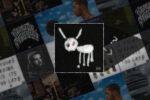Pi’erre Bourne is most commonly known as the producer of rap’s newest generation of talent. The “Yo Pi’erre you wanna come out here” producer tag, which Bourne sampled from an episode of the “Jamie Foxx Show,” has become an iconic introduction on Billboard hits such as Playboi Carti’s “Magnolia” and “Bean (Kobe)” by Lil Uzi Vert featuring Chief Keef. Bourne’s own rap career has been largely overshadowed by his beat-making and production, but the fourth installment in his “The Life of Pi’erre” (“TLOP”) series peaked just outside the Billboard Top 100, which was dramatically better than the moderate SoundCloud success of the previous “The Life of Pi’erre” installments. Since then, Bourne’s clout as an artist has risen tremendously and when he announced the release of “The Life of Pi’erre 5,” it made waves across the hip-hop community — at least for the younger generation.
“The Life of Pi’erre 5” is an album with 16 tracks spanning about an hour of playtime, so for those who want to know which tracks are worth the listen, here is a short assessment of each song.
1. “Intro”
Bourne introduces the project with a call from his grandma, who asks when he’ll be coming back to his hometown of Columbia, South Carolina. The call ends with his grandma telling him she needs a cheap car to ride around in. This call represents a few themes across the album, including Bourne’s come-up, constantly being on the road and feeling disconnected from his family back home.
2. “Switch Lanes”
While a leaked version of this song has amassed millions of streams on SoundCloud, it is still an exciting addition to the album. Unfortunately, the Playboi Carti feature is a bit underwhelming and the hype around the song would most likely have been much larger if the leak hadn’t become so popular.
3. “Hulu”
The third song off the project is a clear highlight. Pierre’s wordplay is at its finest here, with fewer unnecessarily repetitive lyrics and more interesting flows than usual.
4. “Couch”
This track provides an ethereal video game beat mix with a plethora of witty Bourne one-liners.
5. “42”
Bourne comes with a flow similar to Lil Yachty — laid back as if he’s almost not trying. This nonchalant style can be a vibe, but its low-energy chorus leaves the song feeling unresolved.
6. “Biology 101”
A funky bop with a more creative flow than other songs off of “The Life of Pi’erre 5,” “Biology 101” is unfortunately overwhelmed by the repetitiveness of the hook.
7. “YNS”
This song offers a weak chorus combined with more serious lyrics in the verses about Bourne’s dreams growing up, hate from other rappers and stories about helping his family and friends. Bourne raps, “That’s so raven with the grind you know I got these visions.”
8. “Sossboy 2”
“Sossboy 2” is perhaps the best of the singles to come off the album. High energy lyrics from Bourne act as back-to-back jabs on the beat, with great replay value. The beat is also excellent, high energy and disorienting. Uzi walked on the track, killing his features as usual, but the pace of the song is so fast it would have been nice if the tempo changed at some point in the four-minute song.
9. “Practice”
A pretty basic song with some questionable corny lyrics, including, “So strong from eating vegetables” and “Spongebob, Spongebob and Patrick.” Overall, the song has no real content, but as always, the production on the track is top-notch.
10. “40 clip”
The daunting beat makes the listener anticipate that Bourne is going to come in hard, with strong lyrics. No one wanted Bourne to talk about “bologna” on a beat like this. Bourne rides the beat much better on the second half of the song, but everything before 2:30 is mediocre.
11. “Retroville”
Here is another gem off the album, including a nostalgic beat that also feels futuristic — Bourne’s specialty. This is a young love song and it does a great job at representing that through its ambiance.
12. “Drunk and Nasty”
“Drunk and Nasty” is another good song that’s partially ruined by the repetition of a few basic hooks. We get it: You wanna get drunk and nasty. Nevertheless, there’s a great feature from Sharc as well as a solid Bourne verse at the end of the 5-minute track. Bourne also just says “be my bitch” like 87 times throughout this song for no reason.
13. “Amen”
Bourne adds a little extra autotune to his voice as he flows on this dreamy beat that sounds quite reminiscent of many others off of the album.
14. “Groceries”
The second single released before the album, the chorus of “Groceries” is a bit annoying and repetitive, but it is a high-energy banger similar to “Sossboy 2.” Sadly, once again, the repetitive, monotone nature of the chorus takes away from the song as a whole.
15. “Butterfly”
Featuring one of the more interesting beats from the album, “Butterfly” sounds similar to the noise a broken CD-Rom makes — but in a good way. There is a nice differentiation in the speed of the flows, unlike on some other tracks on the album. “Butterfly” is a hidden gem as the album comes to a close.
16. “4U”
The first single Bourne released comes last on the tracklist. Catchy, with fun ad-libs and a minimalist flow that lets the beat do the talking, “4U” is a fun, incredibly well-produced song that has no real memorable content, similar to many tracks off of “The Life of Pi’erre 5.”
Overall, the album is full of great production, beat transitions and one-liners but this is nothing we don’t expect from Bourne already. There is no denying Bourne has talent on the front-end of music, and he has a unique sound that is in many ways ahead of its time. Unfortunately, Bourne’s use of split beats and skits that made “The Life of Pi’erre 4” feel so cohesive wasn’t as strong on this album.
Simply put, Bourne’s artistry as a rapper hasn’t really progressed from his last project, “The Life of Pi’erre 4,” which was a stronger representation of this same sound. What “The Life of Pi’erre 5” lacks are more cohesive hooks and choruses as well as a more versatile flow that matches the creativity of Bourne’s beats and production. The few features feel like unnecessarily short respites from repetitive hooks in the songs they are a part of. Still, his legacy as a producer remains solid.
















